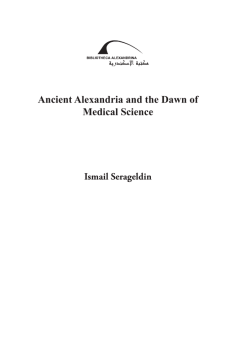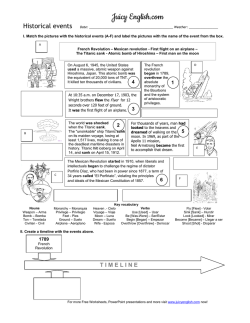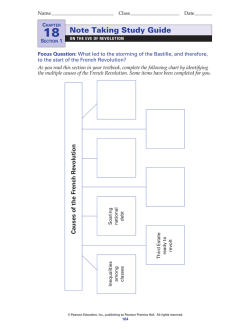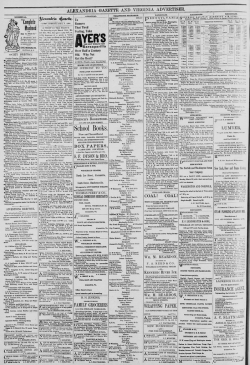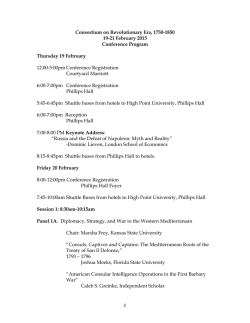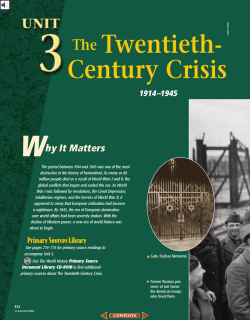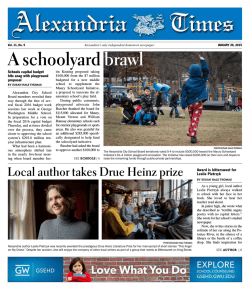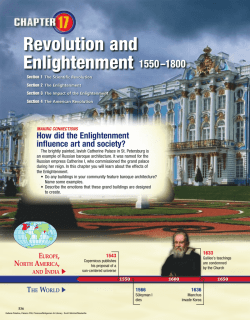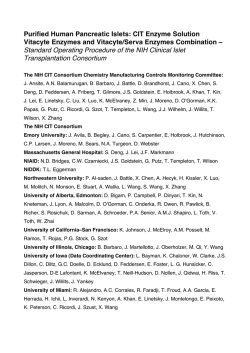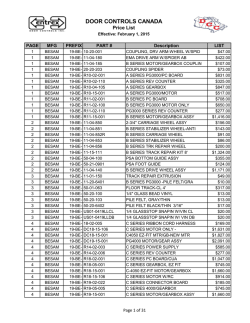
Download - Ismail Serageldin
Public health and private medicine Looking back and looking forwards Ismail Serageldin Introduction Ladies and gentlemen, It is a very distinct pleasure to welcome you here, to the Library of Alexandria, reborn after an absence of 1600 years. The Bibliotheca Alexandrina’s ambition is to once more bring world-class learning, intellectual dialogue and scientific discourse to the very spot where the ancient Library of Alexandria once stood. Yours is the first science group we host in the New Library, a few weeks before our official opening. Please forgive the incompleteness of some of the services as we race against time in the final countdown towards the official opening on 23 April 2002, the International Day of the Book. How appropriate that this gathering should be a meeting of physicians. Alexandrian medicine played an important part in the ancient world, bringing as it did two great traditions: the Greek and the Egyptian into a spectacular Ismail Serageldin fusion that was to advance medicine to a plateau where it was to stay for over a thousand years. The ancient Library of Alexandria started as the Mouseion (the museum) a temple to the muses where the most eminent scientists, philosophers and artists would meet and study and discuss. It was a gathering of brilliant minds devoted to rationality, dialogue, understanding and openness to the other1. On this very spot… • Aristarchus was the first human being to say the earth revolves around the sun; • Eratosthenes proved that the earth was spherical and calculated the circumference of the earth to the amazing accuracy of some few percentage points; • Hipparchus calculated the length of the solar year to within 6 minutes; • Euclid wrote the elements of geometry, • Manetho chronicled the pharaohs and gave the dynasties the names we use to this day; 1 See Mostafa El-Abbadi, The life and fate of the ancient Library of Alexandria, UNESCO, Cairo, 1922 and Roy M. MacLeod (ed) The Library of Alexandria: Center of learning in the Ancient world, I.B. Taurus, 2000. 4 Public health and private medicine • Herophilus identified the brain as the key to control of the body… The great Library disappeared 1600 years ago, overwhelmed by a wave of zealotry that would not tolerate scientific inquiry or philosophical questioning or the opening to the other. Modern Egyptian medicine, which is so ably represented here tonight, is also the product of opening unto the “other”, the modern west. Mohamed Ali Pasha established the Qasr al-Aini School of medicine in 1827. Fifty years later, Sonbol2 tells us, Egyptian medicine had been transformed from a largely medieval practice to a modern one. It went on to become better and better, and some of Egypt’s most eminent physicians are practicing at the most distinguished institutions in the world … • Today you bring the practice of medicine in Egypt to the cutting edge of world knowledge. • Today a great global revolution is looming in medicine • Today the Bibliotheca Alexandrina is preparing to once more become the place to discuss the ethics of 2 Amira El-Azhary Sonbol, The Creation of a medical profession in Egypt 1800–1922, Syracuse University Press, 1991 5 Ismail Serageldin science and its application, to be the window of the world on Egypt and Egypt’s window on the world. Today, I am most privileged to deliver ‘The Ibrahimian Lecture’, named in honor of a great Egyptian pioneer, Dr. Mohamed Ibrahim, who is the person most responsible for the establishment of cardiac surgery in Egypt. I am delighted that his son, Professor Mohsen Ibrahim is with us tonight. We are all in his debt, as his example continues to inspire generations of practitioners. A visionary, he cultivated the healthy skepticism of true scientists, and remained devoted to the noble vocation of healing. It was Dr. Mohamed Ibrahim, and other pioneers of modern medicine in Egypt, such as Aly Pasha Ibrahim who founded the new Kasr el Aini teaching hospital in 1927 and transformed the medical faculties in Egyptian universities, and Dr. Naguib Mahfouz who established a whole school of gynecology, who established modern Egyptian medicine. So: To his memory, a profound salute. I hope that he and they would have approved of what I am about to say. 6 Public health and private medicine My themes for today Throughout the long history of humanity, the art of healing the sick has been the most respected of vocations, and the most appreciated of sciences. Yet the understanding of that long history is flawed, I believe, by the intertwining of two distinct aspects of the question that blur our understanding of many realities. These are public health and individual (private) medicine. Only recently have those two common threads been disentangled (mostly in the last century, but possibly starting in the middle of the nineteenth century). It is of these two threads—public health and private medicine—that I want to speak today. First, I will trace the development of medicine from its origins through its three modern revolutions; and assert that despite the potential of the new scientific revolution in the biological sciences that is at our door, the medical profession is entering a period of deep self-examination, and potential crises due to the perceived divergence of the two threads. Second, I will argue for a new view of medicine that can hopefully help weave the strands together in a strong and 7 Ismail Serageldin sturdy line, a new thread of Ariadne3 for our times, to help get the public and the practitioners on the same plane as the scientists all working for the common good of humanity. Third, and to conclude, I will attempt to sketch out a vision of the future of medicine in this new century.. A future that you will forge by dint of your example and the values that you will instill in your students… So let us start with a brief retrospective… The evolution of modern medicine a retrospective In history, we sometimes refer to revolution.. The industrial revolution, the informatics revolution.. We tend to use these terms to mean major shifts in the sweep of history that have been marked by substantial changes in the condition of massive numbers of people around the planet. Rarely can one pinpoint a single date or event for this transformation. But the history of any topic, and medicine is no different, is not only subject to such sweeping revolutions, but is also punctuated by the 3 In Greek myth, the thread of Ariadne was what enabled Jason to find his way out of the Labyrinth after killing the Minotaur. 8 Public health and private medicine highpoints of individual achievements that have marked the milestones of the road to these broad transformations. So shall it be in my talk today. Broad changes referred to as revolutions and a salute to the major events that punctuate history, the individual achievements that remain an inspiration to us all to this day. The first revolution in medicine It is widely agreed that medicine has gone through a number of genuine revolutions. For myself, I place the first medical revolution in the domain of antiquity, with the Egyptian Imhotep4 as its greatest protagonist. Imhotep, a genius by any measure, builder of the great stepped pyramid of Zoser at Saqqara, was justly immortalized as the Egyptian god of medicine, and his renown as a physician was sustained over millennia, not just centuries. That first revolution was the adoption – at least by some—of the view that disease had a cause and could be cured, and was not just something that had to be endured. Careful observation, experiment and the seeds of the scientific method of empirical trial and error can be traced 4 See B. Jamieson, Imhotep: the Egyptian God of Medicine, London, 1926. 9 Ismail Serageldin back to those dim days of early antiquity. These approaches lead to a variety of treatments, some effective and some totally dubious, if not downright harmful, but they implied belief in the agency of the treatment, including surgery, to effectively bring about a change for the better. The second part of that first revolution came when the efforts were systematically codified into a corpus of knowledge and organized along inductive and deductive lines. The Greek physicians, disciples of Aescalepius and students of Hippocrates, made major contributions to this development but it was in ancient Alexandria that it would truly flourish. Alexandria was to witness a huge expansion in the contributions to medicine. Herophilus5, who lived in the 5 Herophilus of Chalcedon, (b. ca. 335 BC, Chalcedon, Bithynia-d. c. 280),was an early performer of public dissections on human cadavers; and is often called the father of anatomy. He was the greatest physician in ancient Alexandria. By overcoming the Greek aversion to dissection of human bodies, he was able to garner unparalleld knowledge of the human body. He built on the ancient Egyptian knowledge (gained from millennia of mummification as well as medical practice) and introduced rigorous efforts at functional analysis of the organs. studied the ventricles (cavities) of the brain, the organ he regarded as the centre of the nervous system; traced the sinuses of the dura mater (the tough membrane covering the brain) to their junction, known as the torcular Herophili; and classified the nerve trunks--distinguishing them from tendons and 10 Public health and private medicine heady days of the flourishing Library of Alexandria, was the first to bring to bear rigorous anatomical study with major efforts at functional analysis. He not only correctly identified the brain as the key organ of intelligence – as opposed to Aristotle who had argued for the heart – but he also named the duodenum and made many other relevant studies, including the early identification of blood circulation and the measurement of the systolic and diastolic rates of the pulse. Herophilus and his colleague/ student Erasistratus6 were to found the two most successful schools or houses of medicine in ancient Alexandria. 6 blood vessels--as motor or sensory. He rendered careful accounts of the eye, liver, salivary glands, pancreas, and genital organs of both sexes. He described and named the duodenum, at the lower end of the stomach, and the prostate gland. A student of Hippocrates’ doctrine of medicine, which was based on balancing the four humours (body fluids)--blood, phlegm, yellow bile (choler), and black bile (melancholy)--Herophilus emphasized the curative powers of drugs, dietetics, and gymnastics. He was first to measure the pulse, for which he used a water clock. Erasistratus of Ceos, (Flourished ca. 250 BC) is regarded by some as the founder of physiology. He correctly described the function of the epiglottis and the valves of the heart, including the tricuspid, which he named. A former student and colleahgue of Herophilus, he was to separate from him and launch his own very successful school, or house of students and disciples. The differences between the two great physicians was not that significant, and for all intents and purposes they can be considered part of the same Alexandrian medical tradition. 11 Ismail Serageldin The last of the truly great physicians of the ancient world, Galen7, studied at Alexandria before heading back to his native Pergamon and from there to Rome to treat, inter-alia, the emperor Marcus Aurelius and his deranged son Commodus. Thus the first medical revolution was started millennia ago, and gave us some insights, some names, some treatments, the Hippocratic oath, and little else. These products found their way to the 18th century largely unimproved. The torch was passed from the Hellenistic physicians to the Muslim scholars like Al-Razi8 and Ibn Sina9 (Avicenna 7 8 9 Galen of Pergamum, known in latin as Caludius Galenus, (b. 129 AD in Perdamum, died 199 AD in Rome) is considered the father of experimental physiology and was one of the most distinguished physicians of antiquity. Galen’s influence on medical theory and practice was dominant in Europe throughout the Middle Ages and during the Renaissance. Galen studied in Alexandria for a year, and then returned to take the position of physician in a school for gladiators, where he could observe and treat all types of wounds. From there he went on to Rome, and great fame with both the emperor and his son as patients. Abu Bakr Muhammad ibn Zakaria Al-Razi, (b. 251 AH/ 865 AD, d.313 AH/938 AD) Produced in The enormous collection entitled “Al-Hawi” or “the all-encompassing”. He chose this title as his book contained hundreds of clinical observations and pharmacological information. Al-Rāzi was the first to differentiate between chicken pox and measles. He was sometimes referred to in the west as Rhazes. Abu Ali Al Hussain Ibn Sina (b. 370A H/980 AD, d. 428 AH/ 1052 AD), known as Avicenna in western chronicles, produced a 12 Public health and private medicine to the Europeans). They were the great codifiers, organizing all the known knowledge in encyclopedic works10 that defined medieval medicine for hundreds of years, till well past the renaissance. Yet we cannot pass in silence over the enormously fascinating — and largely unacknowledged in the west — contribution of Ibn Al-Nafis11 (d. in 1288), who 10 11 massive encyclopedia “Al-Qanun”, or “Law of Medicine”. It was the greatest systemization of medical knowledge in the history of medicine as he compiled the ‘then’ fragmented information in one integrated system. For centuries, this encyclopedia was considered in Europe and the Islamic countries as one of the basic references in medicine well past the renaissance. Avicenna was the first to use music as a treatment, and also described psychosomatic diseases. Among the notable Arab/Muslim contributions was the collection and classification of the Hellenistic (and Greco-Roman) medical heritage. They classified the works of Hippocrates in a collection of 12 books, and edited the works of Galen in 16 books. They considered these two collections as the masterpieces of medical studies, together with the Dioscorites’ book in pharmacology entitled “Materia Medica”. Ibn Al-Nafis, (Ala’ al-din ‘ali bin abu al-haram, known as Ibn alNafīs, 607–687 AH, 1211–1288 AD) has written one of the greatest medical encyclopedias in history, titled “Al-Shamil fi Al-Sina’a AlTibiyya” or “A Comprehensive Book on the Practice of Medicine”. It was supposed to be completed in 3 volumes, however Ibn alNafīs died after writing “only” 80 volumes. Though incomplete, this encyclopedia was considered by many to be the greatest medical encyclopedia written by a single author. A recent edition has been partially completed and presented by Yusuf Ziedan in an edition issued in Abu Dhabi. 13 Ismail Serageldin was undeniably the first to truly describe the circulation of the blood long before Harvey. This was well before the 16th century anatomical studies of Andrea Vesalius12 or the 17th century work of William Harvey13, modern discoverer (or rediscoverer, or exponent?) of the circulation of the blood (in 1628). But Andrea Vesalius and Harvey represent a transition in the west insofar as they were believers in observation and experimentation, not the power of the views of the ancients. 12 13 Andreas Vesalius, (1514–1564), a Flemish renaissance physician who revolutionized the study of biology and the practice of medicine by his careful description of the anatomy of the human body. He prepared, in 1537, a paraphrase of the work of the 10th-century Arab physician, Al-Razi (known in Europe as Rhazes), probably in fulfillment of the requirements for the bachelor of medicine degree. Basing his observations on dissections he made himself, he wrote and illustrated the first comprehensive textbook of anatomy. This major work De humani corporis fabrica libri septem (“The Seven Books on the Structure of the Human Body”) commonly known as the Fabrica, was printed in 1543, and was a turning point for much of European medicine and science. William Harvey (1578–1657), the leading English physician of the first half of the 17th century, achieved fame by his conclusive demonstration of the true nature of the circulation of the blood and the function of the heart as a pump. His precise methods were to set the pattern for research in biology and other sciences for succeeding generations, so that he is justly recognized as a major contributor to initiating accurate experimental research. 14 Public health and private medicine The three revolutions of Modern Medicine In recent times medicine can count three major revolutions, overlapping and continuing, reinforcing each other to bring better health care to people all over the world. Health care involves both preventive and curative aspects. Let me define the start of recent times with the late 18th century and the start of the 19th century which not only coincides with the industrial revolution beginning to take hold, but also with the ideas of the enlightenment and the American and French Revolutions having their profound impact on western and global history. More relevant to our topic of today, that also coincides with the start of an accelerating series of major contributions that gradually replace our ancient/medieval worldview with something approximating the modern worldview. The honor roll is splendid, to name but a few: 1798 Edward Jenner starts vaccination against smallpox 1840s sees the discovery of anesthesia for surgery 1850sClaude Bernard elucidates the endocrine functions 1859 Charles Darwin changes our view of nature and other species through evolution 15 Ismail Serageldin 1865 Lister invents surgical antisepsis (using carbolic acid) 1880s Pasteur launches bacteriology 1895 Rongten discovers X rays 1890s and early 20th century Freud and Jung and others plumb the psyche But while these punctuating highlights were indeed steps that increased our knowledge of the human body and of the vectors of disease, the net result in terms of massive improvements in human well-being were being silently forged elsewhere. Three great revolutions were coming to health care. The first great medical healthcare revolution was not wrought by doctors at all…It was the work of engineers! In the 19th century and early 20th century, the systematic establishment of proper water works and sanitation in most major cities was probably the First Major Revolution in public health, and it did very significantly reduce the massive problems of water borne diseases that still plague so much of the developing world, where as much as a third of humanity lacks adequate sanitation and about a sixth lack access to safe drinking water, with concomitant infant mortality rates and low life expectancies. 16 Public health and private medicine The next two revolutions were indeed the results of medical research and medical practice: The second revolution came from anesthesia which made surgical interventions much more bearable, while the use of Lister’s antisepsis approach reduced infections. Surgery, with us from the time of Imhotep, came of age in the last hundred and fifty years or so. The third revolution was the pharmacological revolution which came about with the discovery of antibiotics and the much more effective use of chemical medicines. To this must be added the very widespread use of the vaccines that prevented many of the dreaded diseases of the past. Today in the advanced industrial countries, vaccines— direct descendants of Jenner and his milkmaids14—are so common that many scourges have become all but unknown. Not just smallpox, which has been eradicated worldwide, but polio, tuberculosis, measles, rubella, and many other childhood diseases that claim millions of infants worldwide have been largely prevented through systematic vaccination programs. 14 Jenner observed that milkmaids exposed to cowpox seemed to be immune to the scourge of smallpox. He took samples from the scabs that formed on the milkmaids skin and used them to vaccinate healthy individuals against smallpox. 17 Ismail Serageldin Today a new medical revolution is brewing. It is being formed in the womb of the rapidly developing revolution in the biological sciences. Today the biological sciences are on the threshold of a revolution as profound and as exciting as that of physics in the glorious forty years 1905–1945, when all the concepts were changed, from cosmology to atoms, from relativity to quantum mechanics. Nothing would be the same again. Today in biology we are decoding the genomes, we are harnessing bacteria to do our work and we are learning to tinker with the very building blocks of life… Where will this revolution take us? I can see that before the end of this century, medicine, and hopefully public health will be transformed. The practice of surgery will be transformed and radically reduced if not totally abolished as we learn to turn genes on and off, and as mastery of an individual’s pluripotent stem cells allow us to regrow for that individual new organs damaged beyond repair. In addition, new developments into the interface between humans and machines, popularized with cyborgs in Hollywood films, will become real. People will live longer, and geriatric medicine will take on a special role as populations stabilize and even decline with the inevitable reductions of fertility 18 Public health and private medicine flowing in the wake of female education in all countries. By the end of this century we will be looking back at our medicine today at the turn of the century as we look today to the practices in medieval medicine: backward, painful and verging on the barbaric. But that is still a long way off, and medicine and the science that undergirds it still has a long way to go, and there will be many ethical issues that societies will have to face as we advance into that glorious future. So let us come back to the state of medicine and public health today, at the start of the 21st century. Medicine through its three revolutions I just described has made giant strides in the last century. Yet, despite its great achievements15, the medical profession itself is at a crossroads16. To understand that, let us backtrack a bit and disentangle the two threads I mentioned at the outset: the medical treatment of individuals and the public health 15 16 See inter alia, The Editors, “Looking Back on the Millennium in Medicine,” The New England Journal of Medicine, January 6, 2000. There are many critics of the current state of medicine in the west. See inter-alia, James Le Fanu, The Rise and Fall of Modern Medicine, Carroll and Graf, 2001, reviewed by Horton, R. in NYRB November 2, 2001). Horton, also cites the work of Gordon – of the “doctor in the house” fame, as an in-house critic of the state of the practice of medicine in the late 20th century. See Richard Gordon, The Alarming History of Medicine (Mandarin, 1993) 19 Ismail Serageldin aspects of the management of healthcare. Sub-themes exist in each of these two main threads. On Public Health and Private Medicine Medicine and public health have become intertwined in the public mind. Yet they are very different things, and though mostly complementary, they can nevertheless sometimes work at cross-purposes. The first, medicine, is largely focused on the health of the individual. The second is focused on the average health of the entire population measured statistically. Kerr White17 identified the year 1916 as the decisive point at which in the United States that distinction became clear. The Rockefeller foundation started funding the establishment of the first schools of public health independent of schools of medicine. Richard Horton attributes to this decision the “…abandonment of the social impulse within American medical education. This division contributed to the 17 Kerr L. White, Healing the Schism: Epidemiology, Medicine, and the Public’s Health (Springer – Verlag, 1991), p.xi 20 Public health and private medicine origination of two distinct histories of western medicine, histories that had until then been indivisible.”18 The divergence of the two histories as Horton sees it can be immediately grasped if we review what the Centers for Disease Control and Prevention consider the ten greatest milestones of public health19: • • • • • • • • • Vaccination Motor vehicle safety Safer workplaces Control of infectious diseases Declines in death from coronary and heart disease and stroke Safer and healthier foods Healthier mothers and babies Fluoridation of drinking water Recognition of tobacco as a health hazard No medical procedures figure in that list20. Increasingly, people view national policy, public education programs, 18 19 20 Richard Horton, “How sick is modern medicine?” in NY Review of Books (NYRB), 2 November 2000, p.48 . cited in Richard Horton, op.cit. NYRB, p.47. compare that to the more standard list of medicine’s view of the milestones, not very different from the honor roll that I cited in the preceding section. See inter alia, Meyer Friedman and Gerald Friedland, Medicine’s 10 Greatest Discoveries (Yale University Press, 1998), pp.1, 37; and Horton op.cit. passim. 21 Ismail Serageldin sound diets and lifestyles, counseling, vaccination, and environmental hygiene as keys to preventative medicine and public health. This is in contrast to the deepening focus of individual treatments of severely sick persons, which remains at the heart of the individual medical practitioners’ professional sense of pride. Bringing these two strands together is at the core of the challenge of transformation of medicine for the new century. The Transformation of Medicine today The fundamental shift from individual medicine to public health is the shift from curative to preventative as well as the shift between the concerns with the health of individuals to the health of entire populations. The conflict arises when the allocation of funds is at stake. The role of research and of public support programs is an issue: • How much new technique is required versus making what is already known more accessible to larger numbers of people? 22 • How much to develop new treatments versus how much to accelerate the transition of treatments from lab to patients and to scale up the application of known beneficial care to large numbers of individuals? The issues are being complicated by the evolving nature of the medical and public health enterprises. On the medical side, we note: • Enormous specialization • The fragmentation and complementarity of much health care • Divergence between research and clinical work, Then there is the manner in which the enterprise is undertaken. Clinical trials increase. Mark Chassin21 observed that in 1966 there were 100 clinical trials randomized controlled trials in peer-reviewed journals. In 1995 there were 10,000. Yet these studies do not bridge the gap between the researchers and the practitioners who become increasingly identified as separate communities. 21 quoted by Shine, Op.cit. p.11 Ismail Serageldin On the public health side the issues are somewhat different: Concern with the public–private divide is growing more acute. The role of private providers of treatment (big pharmaceutical companies as well HMOs) vies with a perception of profit versus need. It is noteworthy that “The current profit margins of the US pharmaceutical companies is in the range of 18%. They have a substantial R&D commitment, but also spend 40% of their money on marketing and relate activities.”22 I am not faulting private companies, I am faulting public authorities that forget that public goods (in economic terms) must be funded by the public purse. Adam Smith, father of the invisible hand said in The Wealth of Nations: “…the state is responsible for ‘erecting and maintaining those public institutions ... which though they may be in the highest degree advantageous to a great society, are, however, of such a nature, that the profit could never repay the expense to any individual or small number of individuals, and which it, therefore, cannot be expected that any individual or small number of 22 Shine. Op.cit. p.11 24 Public health and private medicine individuals should erect or maintain.”23 That is the case with vaccination, environmental hygiene and much of the preventative aspects of public health. So the shifting boundaries of the public and private domains in the provision of health services remains an area of concern and one where many of the issues of the new century shall play out… Today’s institutional arrangements are also part of the problem, because they are perceived as competitive rather than complementary, and because we do not effectively weave into a common fabric the roles of the many who labor in the domain of health. And they are many. Eli Ginsberg observed that in 1927 there were two health providers (Health-care workers) for every physician in the United States. By 1999 there were sixteen24. We need teams to provide excellent care. Teams working in hospitals, in schools, in community centers, all working like musicians in an orchestra, playing different music but the whole producing a great symphony … The whole is greater than the sum of the parts… 23 24 cited by Arati Prabhakar “technology Infrastructure”, in Scientific American, September, 1995, pp.193-194. Eli Ginsberg, cited by Shine. Op.cit. p.15 25 Ismail Serageldin To achieve this we need two things, and they start with the medical doctors: First, to change the notion of solo practice. Second, to rethink the prevailing values of medical practice in the last twenty years or so. Keneth Shine, President of the US Institute of Medicine, in his farewell speech October 2001 called the medical profession a cottage industry! He said: “We are the largest cottage industry in the world. We have huge cottages that have various types of technology in them. They have poor communication, both internally and externally.”25 There is much to support that view. Computer records are driven by specialized studies of cardiac care or children’s cancer… but not systematically to cover the whole population of patients. Much less the whole external population. Managing this huge data will require IT, which offers enormous potential for system-wide connectivity, potential that is still sorely underutilized. Setting up such systemwide approaches would be costly, but not as costly as many other areas where funds are expended today. 25 Shine,op.cit. p.9 26 Public health and private medicine Are we paying for increasingly minor variations of an existing technology? Is there redundancy in the system? How much additionality is there in the variations from cat scans, MRIs etc.? Here it is pertinent to ask: Are we paying for major advances or minor variations? Variations that do not actually advance the treatments much? While recognizing that many technologies advance incrementally, we still need to question the emerging pattern of research and practice in a place like the US which spends infinitely more than many European countries and whose bio-medical research enterprise is justly envied across the planet, but still ranks very low on indicators of overall health of the population and of the dispersal of those indicators over the various sub-groups of the population. So, as we enter the 21st century, the work of medicine has now broken down into its constituent parts. The researchers are increasingly separated from the clinicians among the doctors, the physicians now rely on armies of specialized health personnel and the bio-medical enterprise churns on with all the constituent parts…. The public health enterprise is connected but separate from the medical enterprise. The focus on prevention 27 Ismail Serageldin does occasionally come together (annual checkups, mammograms, child vaccinations,…) On the horizon looms the promise of the great biological revolution… Visions for tomorrow Allow me now to get into really difficult territory: Predictions I predict that the transformation of medicine and public health in the 21st century shall indeed take the path of integrating the health care professions into a true system of healing and health. Let me to sketch out the likely scenario of this development: The next twenty years are going to bring us face to face with a profound confrontation of the privatization of science, and the patenting of knowledge. New ethical dilemmas shall be highlighted as we debate medicine as a commercial service and public health as a public good. The trigger of the dispute will be the price of medicine, especially in the less developed countries. We have already seen this in the case of AIDS and we will see it repeated 28 Public health and private medicine in the case of other medicines, linked directly to the new rounds of global trade talks following on the Doha WTO meetings. The next twenty years will also see a whole new approach to bio-ethics as the new technologies open up avenues that hitherto remained in the domain of science-fiction, and as public fears of scientists running wild will try to curb research. I predict that reason will prevail, and scientific research will continue apace. The future is being framed by the new biology. The promise of the genome is only going to be realized over the next two decades. Proteomics and metabolomics will complement the genomics we have come to know. Establishing the Proteome, the total protein complement of the human cell, will open up whole new vistas for medical research and application. Bioethics, already an important topic for researchers will become much more so for practitioners of medicine and healthcare. Private medicine will have to face choices on the possibilities of tinkering with genes of a fetus to avoid lifelong disabilities or crippling inherited disease. If such choices seem straightforward to many, there is the slippery slope of how far to go before we go from life29 Ismail Serageldin saving interventions to interventions with unborn child for esthetic reasons, the specter of designer babies on the horizon. After all, cosmetic surgery is very much with us today, but it is usually practiced on patients who are consenting adults. But while many of the issues on private medicine will be new, many will be extensions of the emerging debates on bioethics that the new biology has already triggered in western societies. More difficult will be the somewhat different issues that will be raised in the domain of bioethics for public health, or population-wide bioethics. There questions such as “What should societies do about health inequalities?” Should the goal be equality? Or should the goal be maximum improvement for the worstoff? If the health of all groups is improving over time, is there a problem, even if the gaps between the healthiest and the least healthy is growing? These many other questions will have to be faced by doctors, healthcare specialists and societies at large before too long. But let me get back to the practice of medicine. The 2020s shall see the transformation of the practice of medicine from the largely solo practice that exists today 30 Public health and private medicine towards the establishment of truly integrated systems of healthcare. So: Instead of solo practice, we must think of systems of care… Instead of visit-based care, we must think of continuous healing relationships… Instead of professional autonomy driving variability, we must think of customized care according to patient needs… Instead of professionals controlling care… we must think of the patient as the source of control Instead of information as a record, we must think of shared knowledge and information flowing freely.26 These are the hallmarks of the new 21st century integrated system of medicine and health care… A system where decision making will increasingly be evidence based. Transparency shall replace secrecy. 26 Source IOM table 3-1 Crossing the Quality Chasm: A New Health System for the 21st Century, IOM 2001. ( also see Shine, op.cit., p.14, fig7,) 31 Ismail Serageldin Safety shall be a system property, not just an individual responsibility to do no harm. A system where cooperation among clinicians shall be the norm, and where waste is continuously decreased rather than seeking cost reductions by HMO management fiat… By the middle of the century, the revolution will be almost complete: the new treatments will be in place, and the practice of medicine will have experienced as profound a transformation in those 50 years as was experienced in the years between the 1920s and the 1970s. But whereas the closing decades of the last century saw only incremental improvements, the second half of the 21st century will see dramatic new shifts in the very concept of treatment as the genetic revolution takes hold. From switching the genes on and off, and the coding for particular proteins, the replenishment of particular constellations of cells, the re-growth of organs at will, and so much more…. all of that will become possible and feasible. The world of our grandchildren will be a truly different one from our own. 32 Public health and private medicine Envoi Ladies and Gentlemen, We have come a long way in the last thirty minutes: From ancient Alexandria through the Middle Ages to the pride of modern medicine… We traced modern medicine through its three revolutions: • Public health (water and sanitation) • Anesthesia and surgery • The pharmacological revolution and anti-biotics We looked into the pending fourth great revolution as we realize the promise of the new biology. We tracked the divergences and the coming together of public health and private medicine, rejecting the false dichotomy and recognizing the inescapable complementarity between the health of individual patients and the average health of entire populations. We peered into the future and what the 21st century can hold… In all this, you have been patient travelers and explorers, for like all doctors, you are committed. Scientists, you are 33 Ismail Serageldin committed to the search for truth, … Healers, you are committed to the betterment of the human condition… Together we have searched and explored in our hearts for what is right, for us, for our children and for the world, and like all explorers … We shall not cease from exploration And the end of all our exploring Will be to arrive where we started And know the place for the first time. …(T.S. Eliot) Thank you. 34 Ismail Serageldin, Director, Library of Alexandria, also chairs the Boards of Directors for each of the BA’s affiliated research institutes and museums. He serves as Chair and Member of a number of advisory committees for academic, research, scientific and international institutions. He has held many international positions including as Vice President of the World Bank (1993– 2000). Dr. Serageldin has received many awards including: First recipient of Grameen Foundation (USA) Award for a lifetime commitment to combating poverty, (1999); Officer of the Order of Arts and Letters awarded by the government of France (2003); Pablo Neruda Medal of Honor, awarded by the Government of Chile (2004); The Bajaj Award for promoting Ghandian values outside India (2006); Order of the Rising Sun – Gold and Silver Star awarded by the Emperor of Japan (2008); Champion of Youth Award by the World Youth Congress, Quebec (2008); Knight of the French Legion of Honor awarded by the President of France (2008); The Swaminathan Award for Environmental Protection (Chennai, India, 2010); Millennium Excellence Award for Lifetime Africa Achievement Prize, by the Excellence Awards Foundation, Ghana (2010); The Public Welfare Medal, by the National Academy of Sciences, Washington DC (2011); Commander of the Order of Arts & Letters awarded by the government of France (2011). He has lectured widely all over the world including delivering the Mandela Lecture (Johannesberg, 2011), the Nexus Lecture (Netherlands, 2011), the Keynote Address to the First International Summit of the Book (Washington DC, 2012). He was distinguished professor at Wageningen University and at the College de France. He has published over 60 books and monographs and over 200 papers on a variety of topics including biotechnology, rural development, sustainability, and the value of science to society. He holds a Bachelor of Science degree in engineering from Cairo University and Master’s degree and a PhD from Harvard University and has received over 30 honorary doctorates.
© Copyright 2025
